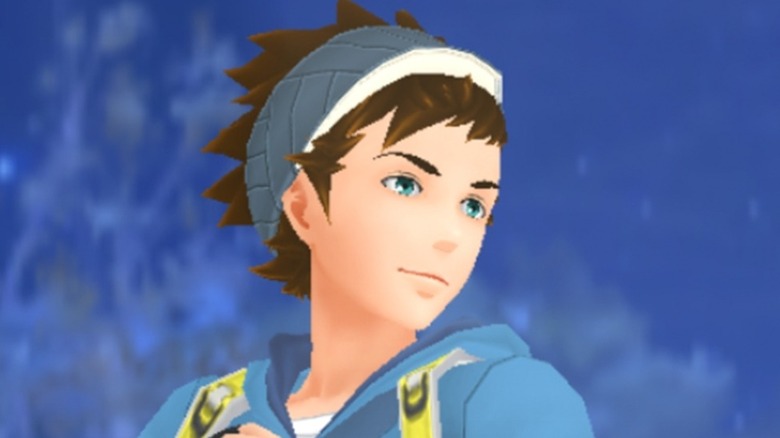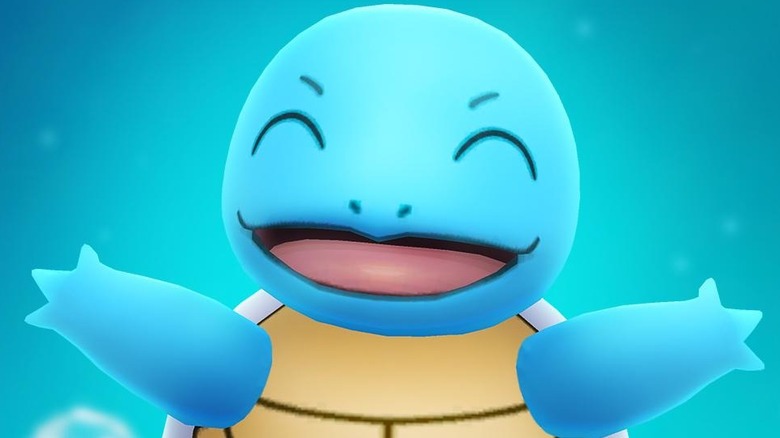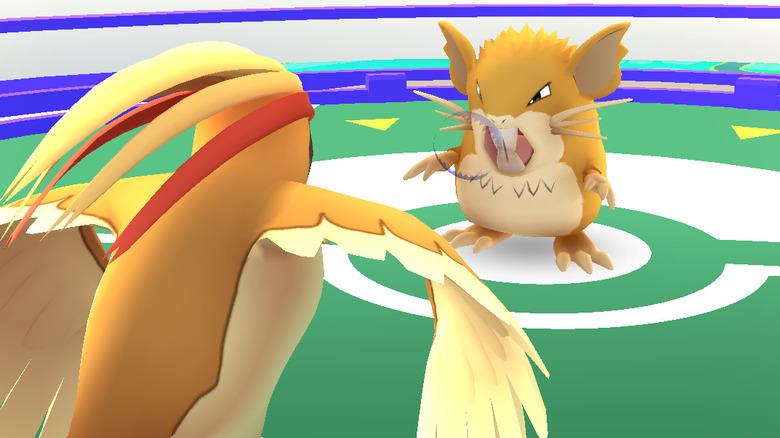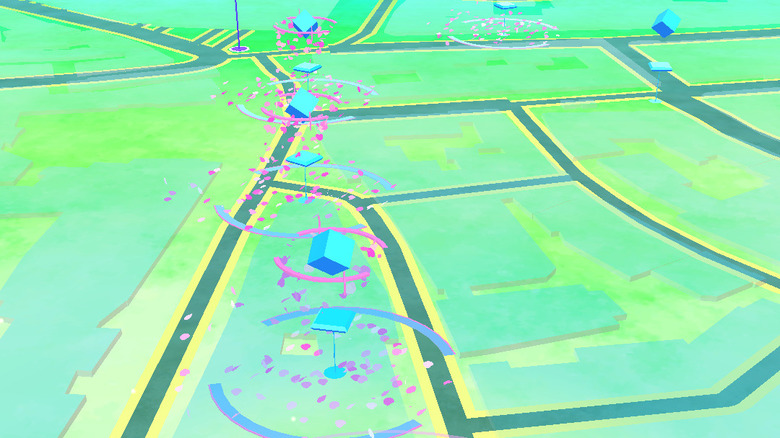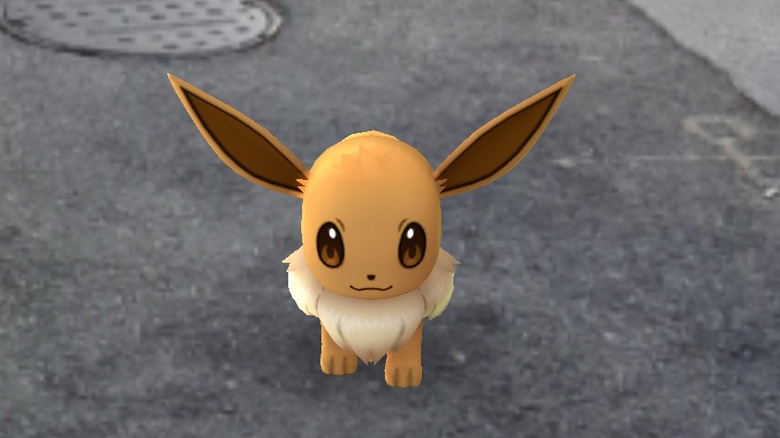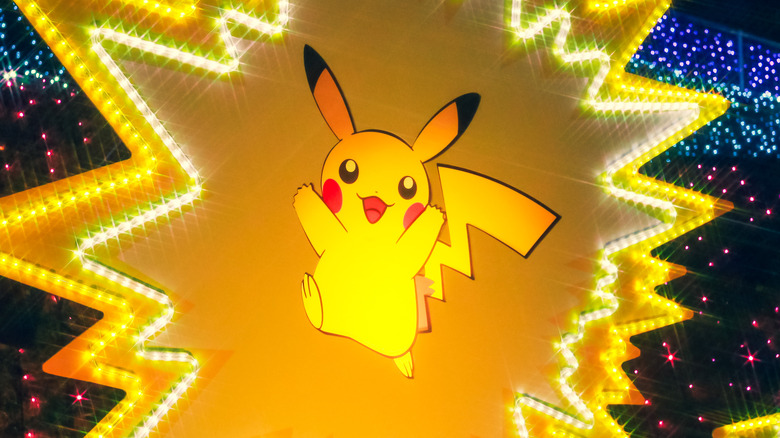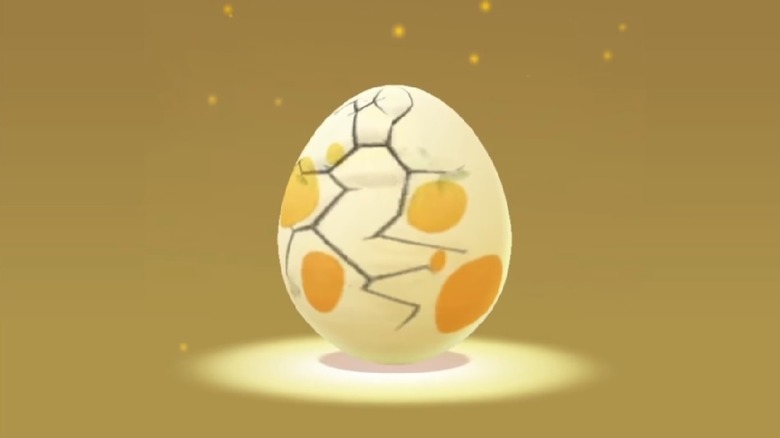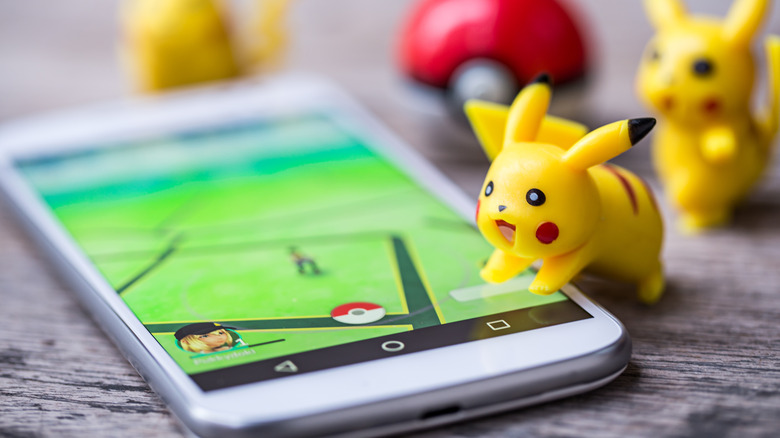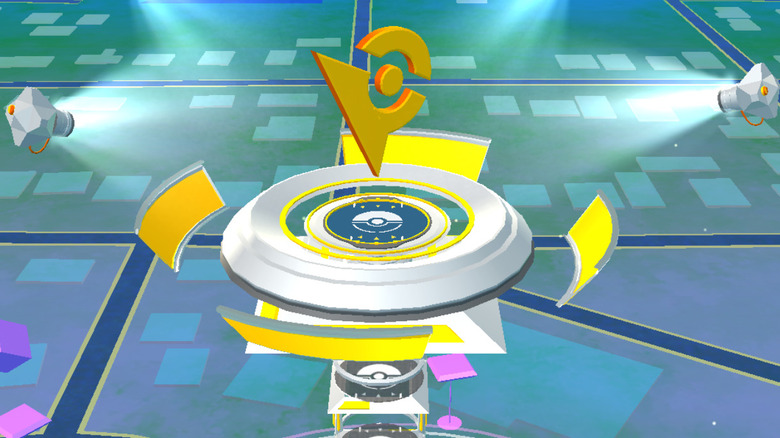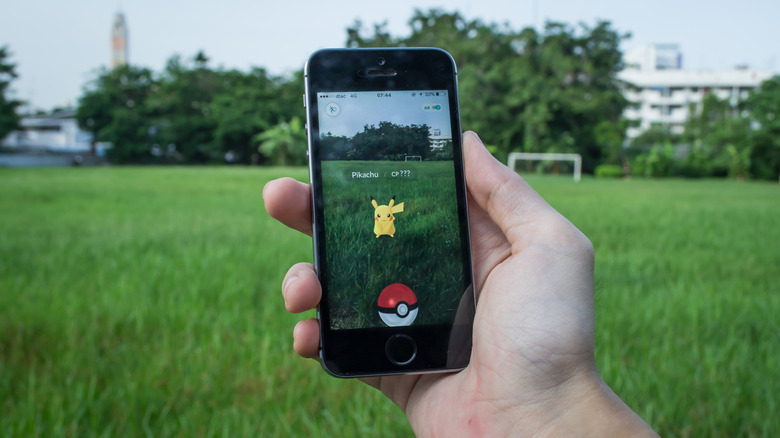Things Only Adults Notice In Pokemon Go
The "Pokemon" franchise has dazzled fans for more than a quarter of a century. Showing no signs of slowing down, innovative titles like "Pokemon Go" keep the franchise on the forefront of gaming culture. The sustained success of "Pokemon Go" stems from a combined effort between iconic branding, nostalgia, and an addictive gameplay loop. The blend of walking-as-a-mechanic and cutting edge augmented reality gameplay makes "Pokemon Go" a truly unique experience.
With its global playerbase, it is safe to say that "Pokemon Go" has cultivated a community of wide-ranging ages. Back when it was released in 2016, there were players of all ages roaming local parks and community hangouts for Pokemon. Some people have even skirted the law in their pursuit through restricted areas! But do younger and older players experience the same game when playing "Pokemon Go?"
Simply put, "Pokemon Go" likely comes across very differently for that contingency of players who have been trying to catch 'em all for decades.
Candied Pokemon
The evolution process in the "Pokemon" game franchise is a sacred act. Growing a Squirtle from a little water-spitting turtle to a water-cannon-shelled Blastoise brings to life the promise of RPG-progressions like no other franchise. Pokemon normally evolve after a certain level is reached, which is in turn gated by experience points. "Pokemon Go" isn't a classic RPG-battler like the main series, so it required a dynamic solution to evolutions.
Instead of accruing experience points, Pokemon in "Pokemon Go" evolve through the use of Candies for that specific Pokemon. Candies are obtained by catching Pokemon. For instance, catching a Pikachu will net the player the electric mouse and 3 Pikachu Candies. If the player "Transfers" the Pokemon to Professor Willow, then one candy of that Pokemon — in this case, one Pikachu candy — is received in exchange for that Pokemon's soul.
In a game franchise with a competitive scene evoking unexpectedly adult themes — like breeding Pokemon only for the "most desirable" traits — "Pokemon Go" manages to make the evolution process even more ethically questionable. Are we really turning Pokemon into Candy and then feeding them to another Pokemon of the same species to pump them up? The line here is blurry, but it just doesn't feel right to help the most powerful Pokemon chow down on the "Candy" of the weaker ones.
Stardust is not made of Pokemon dreams, it is made of cold, hard cash
The smash hit success of "Pokemon Go" in late 2016 catapulted it to the highest ranks of mobile games across the world. And although the game's playerbase peaked after this initial mania, its revenue has steadily grown ever since that industry-shaking launch (per Business of Apps).
Maintaining a profitable balance sheet for free-to-play mobile games requires companies to integrate microtransaction systems or fill their game with ads. Niantic, the developer of "Pokemon Go", eschews advertisements in favor of microtransactions galore.
In order to enable a microtransaction game-economy, then multiple in-game currencies typically need to exist: one earned with in-game time spent that is used for almost every game action, and another purchasable with real-life currency (which may be more efficient than the free currency).
"Pokemon Go" follows this model. Stardust is required for almost all game actions like evolving, trading, and learning new moves, and is earned by catching Pokemon — which is gated by Pokeballs. If players run out of Pokeballs they receive from PokeStops (which happens more for players outside of urban areas), they'll need to buy PokeCoins with real money. The cycle of always needing more Stardust ends up leading players to buy more PokeCoins. Niantic has thankfully upped Stardust drop rates over time and introduced PokeCoin generation for holding gyms, making "Pokemon Go" a bit more casual-friendly.
Perfected Pokestop Routes
Adults know that food needs to be put on the table, the taxman needs to be paid, and money doesn't grow on trees. In order to make ends meet, adults simply don't have as much time to play games as kids do.
Gamers therefore adapt their playtime habits as they get older. As noted by Kotaku, Squeezing in a few hours of play in-between responsibilities — as opposed to all-night binges — becomes many an adult's reality. When the responsibilities of the surrounding world are more present, that precious gaming time must be optimized.
Because of this, many adult players of "Pokemon Go" probably relate to the fantastic feeling of having a PokeStop in range of their workplace. Oftentimes, these workplace-centered PokeStops will be perfumed at all times of the day. Being able to collect plenty of items and Pokemon can really take the sting out of a long day of work.
Likewise, "Pokemon Go" adults probably know which local park has the most efficient walking paths for Pokemon hunting. When one doesn't have much extra time, figuring out which path has the most PokeStops per step becomes a game in and of itself.
Anti-Abuse Mechanisms
In-game economies are sometimes just as complicated as the real thing — and these complex systems are harder to work out the younger and more inexperienced players are.
"Pokemon Go" is not a game with a robust economy like many MMORPG giants. The reliance and relative scarcity of Stardust for players of "Pokemon Go" is core to the game's profitability. However, the game also has a very young playerbase that must be protected by diligent game design.
An example of a keen anti-abuse measure in "Pokemon Go" exists in its trading system. In order to trade Pokemon, a certain amount of Stardust is required from both players. The more rare or powerful the Pokemon, the more expensive the Stardust cost. These rare trades are called Special Trades, and only one of them can be completed per day. Player friendship levels are also taken into account, with very high upfront costs for level 1 friends and almost non-existent costs for level 5 friends.
These measures might not seem like much, but in effect, they prevent players from making unfair trades with random strangers. Older, more savvy fans might not make this mistake, but these measures protect more vulnerable players, like kids, who are likely naïve to their assets' worth.
Where would Pokemon Go be without the Gen 1 Pokemon?
Over the years, the Pokemon Company has released 22 Pokemon games across 8 generations. "Pokemon Scarlet" and "Violet" are set to release in 2022, ushering in the Ninth Generation of Pokemon. As noted by outlets like Nintendo Life, one constant has remained the same across all those iterations: Generation 1 Pokemon are the most popular. The most iconic, recognizable Pokemon upholding the behemoth brand are nearly all from Generation 1, including heavy-hitters like Pikachu, Charizard, Mewtwo, and Eevee.
Niantic surely knew that the heart of the Pokemon brand lies with these original characters. Plus, the crowd of players most likely to have disposable income to spend on their game are adults who grew up with Gen 1 Pokemon. So naturally, "Pokemon Go" released in 2016 with only Generation 1 Pokemon available to catch, train, and trade.
Back in 2016, the most recently-released Pokemon games, "Pokemon Sun and Moon," brought the 7th Generation of Pokemon to the small screen. Niantic could have chosen to immediately stay up to date with the newest release, or otherwise blended Pokemon from prior generations together. Instead, Niantic's decision to stick with the core 151 Pokemon from Gen 1 probably netted the title a more dedicated fanbase right off the bat, simply because people were more instantly familiar with those older Pokemon.
Pokemon Go, the exercise tool
When the Nintendo Wii was released in 2006, a large contingent of its marketing plan was geared towards adults who could repurpose the game console as a workout tool (per Population Health Learning Network). A marketing push touting games like "Wii Sports" and "Wii Fit" as healthy investments successfully landed each among the best-selling games of all time. Without a doubt, this era proved there is a large audience for gamified exercise.
As noted by outlets such as Men's Journal, the "Pokemon Go" community is a prime contemporary example of this trend. While further illustrating the idea of optimized playtime for adult gamers, workout-oriented members of the "Pokemon Go" community have incorporated the game into their diet and exercises. After all, "Pokemon Go" is designed to be played while walking — it's only natural for players to want to emphasize the healthier aspects of the title.
While it may feel good just to get some fresh air while racking up those steps to hatch an egg, some players find it feels even better to turn "Pokemon Go" into a strict workout itself. Hatching eggs for these players is less about gaining Pokemon and more about finishing the reps of a routine.
Some of these "Pokemon Go" workout routines change depending on the player's in-game performance. For instance, one routine from Shape suggests, "For every missed ball, do 4 push-ups." In many ways, players have found that "Pokemon Go" is perfect for adult gamers who don't have enough time to budget for the gym.
Real Friends
A unifying theme across the "Pokemon" franchise is the power of friendship. Even the anime's eternal theme song echoes this: "Oh, you're my best friend, in a world we must defend ... You teach me and I teach you, Pokemon!" The relationship between protagonists and Pokemon themselves is also framed as friendly.
"Pokemon Go," one of the most multiplayer-reliant experiences in Poke-history, literally built friendship as a mechanic into the game. For each person on a player's friend list, there is an assigned Friendship Level that ranges between 1 to 5 stars. These Friendship Levels grant players bonuses for playing the game together. Whether earning the ability to trade Pokemon at a discounted Stardust rate or acquiring more loot for boss raids, leveling up these friendships is important.
There are multiple ways to level up friendship with another person in "Pokemon Go," but the best and most consistent method is simple: Give them gifts, everyday.
Naturally, people typically maintain fewer peripheral relationships and stick to just their closer friends as they get older — but according to "Pokemon Go," true friendship is only based on buying favors.
Gym Turf Wars
Gyms in normal "Pokemon" titles represent checkpoints that benchmark the power and progression of a trainer. They're also typically themed around a specific a Pokemon type, like Gym Leader Brock's iconic Geodude/Onyx combo, and players have to adapt specific strategies to win.
Gyms in "Pokemon Go," however, turn the gyms into nodes to be battled over in a larger turf war. The three-pronged Team system of "Pokemon Go" is reified most clearly by these fights for control. Players are incentivized to hold Gyms with their most powerful Pokemon because they receive precious PokeCoins for the amount of time their Pokemon survives in the Gym. Additionally, these captured Gyms act as PokeStops for players of the controlling faction.
Because of this dynamic, finding a local Gym is a blessing — but finding out that gym is contested by active players of an opposing Poke-gang is a curse. The war turns into a mafioso-style contest to claim territory. Conflict only becomes more and more desperate as every Potion and Revive available gets thrown into the frontlines. Some of these contests have even turned into real life confrontations (at least according to fans on Reddit)!
Outdoor Danger
The initial launch of "Pokemon Go" constituted a social phenomenon wide enough to receive mainstream media coverage. Criticism from outside the gaming community levied against "Pokemon Go" — often from concerned parents — claimed that "Pokemon Go" was dangerous to play because it demanded its players stare down at their phone screen while walking in public places. Enough fear around "Pokemon Go" fermented that numerous fake stories and hoaxes about weird tragedies connected to the game began to spread across the internet.
Despite cooking up a weird hysteria in some places, it has turned out that some of the more basic fears about attention were well-founded. In a viral incident covered by CNN, a driver playing "Pokemon Go" smashed into a parked cop car. Another story reported by Good Morning America involved a "Pokemon Go" streamer getting attacked while playing after dark. It has become difficult for more mature players to ignore the possible dangers that come from playing this innocent game.
While "Pokemon Go" certainly deserves praise for getting gamers to go outside and touch some grass, it does stand true that playing it can be a liability. Be careful out there when trying to catch 'em all!

